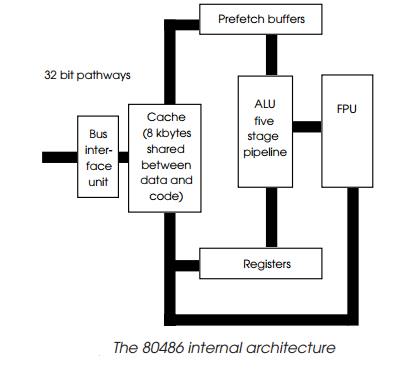Chapter: Embedded Systems Design : Embedded processors
INTEL 80486
INTEL 80486
The Intel 80486 processor is essentially an enhanced 80386. It has a
similar instruction set and register model but to dismiss it as simply a
go-faster 80386 would be ignoring the other features that it uses to improve
performance.

Like the MC68040, it is a CISC processor that can execute instructions
in a single cycle. This is done by pipelining the instruction flow so that
address calculations and so on are per-formed as the instruction proceeds down
the line. Although the pipeline may take several cycles, an instruction can
potentially be started and completed on every clock edge, thus achieving the
single cycle performance.
To provide instruction and data to the pipeline, the 80486 has an internal
unified cache to contain both data and instructions.
This removes the dependency of the processor on faster external memory
to maintain sufficient data flow to allow the processor to continue executing
instead of stalling. The 80486 also integrates a 80387 compatible fast floating
point unit and thus does not need an external coprocessor.
Instruction set
The instruction set is essentially the same as the 80386 but there are
some additional instructions available when running in protected mode to control
the memory management and floating point units.
Intel 486SX and overdrive
processors
The 80486 is available in several different versions which offer
different facilities. The 486SX is like the 80386SX, a stripped down version of
the full DX processor with the floating point unit removed but with the normal
32 bit external data and address buses. The DX2 versions are the clock doubled
versions which run the internal processor at twice the external bus speed. This
allows a 50 MHz DX2 processor to work in a 25 MHz board design, and opens the
way to retrospective upgrades — known as the over-drive philosophy — where a
user simply replaces a 25 MHz 486SX with a DX to get floating point support or
a DX2 to get the FPU and theoretically twice the performance. Such upgrades
need to be carefully considered: removing devices that do not have a zero
insertion force socket can be tricky at best and wreck the board at worst.
Similarly, the additional heat and power dissipation has also to be taken into
consideration. While some early PC designs had difficulties in these areas, the
overdrive option has now become a standard PC option.
The DX2 typically gives about 1.6 to 1.8 performance im-provement
depending on the operations that are being carried out. Internal processing
gains the most from the DX2 approach while memory-intensive operations are
frequently limited by the external board design. Intel have also released a DX4
version which offers internal CPU speeds of 75 and 100 MHz.
For embedded system designers, these overdrive chips can be a gift from
heaven in that they allow the hardware performance of a system to be upgraded
by simply swapping the processor. As the speed clocking is an internal
operation, the external hardware timing can remain as is without affecting the
design. It should be stated that getting the performance budget right in the
first place is always preferable, but having the option of getting more
per-formance without changing the complete hardware is always useful as a
backup plan. It should be remembered that this solution will only address CPU
performance issues and not prob-lems caused by external memory access delays or
I/O speed problems. This approach can be used with many other processors where
a pin compatible but faster CPU is available.
Related Topics